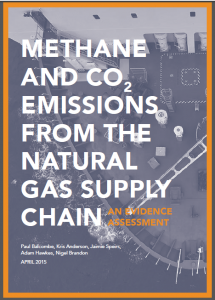This blog post was co-authored by Dr Semra Bakkaloglu, Dr Jasmin Cooper, and Mr Luke Dubey.
 Hydrogen is a low carbon fuel as it produces zero carbon dioxide when burnt and because of this, it has taken centre stage in the fight against climate change. However, a recent publication has raised questions on how effective it is in decarbonising the global energy mix. While it is positioned to replace fossil fuels in the global energy mix, there is growing uncertainty on whether it is as ‘clean’ and ‘green’ as people say it is. Several nations, such as the UK, Japan and Canada, have unveiled their decarbonisation strategy with hydrogen replacing natural gas, in addition to committing to ambitious, world-leading projects to promote it as a fuel in low carbon energy systems. For example, the UK’s recent hydrogen strategy aims for 5 GW of low carbon hydrogen production by 2030 (BEIS, 2021). Hydrogen has the potential to change the way we power our lives and could be critical in combating climate change and achieving net-zero goals.
Hydrogen is a low carbon fuel as it produces zero carbon dioxide when burnt and because of this, it has taken centre stage in the fight against climate change. However, a recent publication has raised questions on how effective it is in decarbonising the global energy mix. While it is positioned to replace fossil fuels in the global energy mix, there is growing uncertainty on whether it is as ‘clean’ and ‘green’ as people say it is. Several nations, such as the UK, Japan and Canada, have unveiled their decarbonisation strategy with hydrogen replacing natural gas, in addition to committing to ambitious, world-leading projects to promote it as a fuel in low carbon energy systems. For example, the UK’s recent hydrogen strategy aims for 5 GW of low carbon hydrogen production by 2030 (BEIS, 2021). Hydrogen has the potential to change the way we power our lives and could be critical in combating climate change and achieving net-zero goals.
Currently, hydrogen is mostly used in industrial (e.g. oil and gas refining, chemicals production, fertiliser production) applications and is not an important fuel source (i.e. it is not used in electricity generation and domestic heating). Most of the world’s hydrogen is made from fossil fuels (natural gas and coal) but only a small percentage is made using electrolysis (water splitting in electrolysers). The hydrogen supply chain is not simple. Hydrogen can be produced from a wide range of materials (water, fossil fuels, biomass) and there are numerous technologies available for converting these materials into hydrogen. Because of the complexity in production routes, a colour code is often used when referring to hydrogen.
What colour is hydrogen?
For hydrogen produced from fossil fuels there is:
- Black hydrogen produced from black coal and the carbon dioxide produced during the process is released to the atmosphere.
- Brown hydrogen made when brown coal is used to make hydrogen and the carbon dioxide produced during the process is released to the atmosphere.
- Grey hydrogen made from natural gas and the carbon dioxide produced during the process is released to the atmosphere.
- Blue hydrogen made from coal or natural gas but differs in that the carbon dioxide produced is captured and stored in underground storage e.g., salt caverns, depleted oil and gas fields.
- Turquoise hydrogen is produced from natural gas, but solid carbon is produced instead of carbon dioxide.
When hydrogen is produced using electrolysis, the electricity source determines the colour code used:
- Green hydrogen is when the electricity is from renewable sources (wind or solar).
- Pink hydrogen is when the electricity is generated by a nuclear power plant- can also be referred to as red or purple hydrogen.
- Yellow hydrogen is when grid electricity, or a mix of electricity sources (renewable, fossil fuels, nuclear) is used to power the electrolyser. It can also describe hydrogen produced from solar powered electrolysers.
Is hydrogen as clean as we think?
Here at the Sustainable Gas Institute (SGI) at Imperial College London, we have been investigating methane emissions and the importance of this greenhouse gas (GHG) since 2015. Methane is a potent GHG with a global warming potential (GWP)* of 29±11 (Forster et al., 2021) and therefore, reducing the amount of methane in the atmosphere is critical for limiting the impacts of global warming and climate change.
emissions and the importance of this greenhouse gas (GHG) since 2015. Methane is a potent GHG with a global warming potential (GWP)* of 29±11 (Forster et al., 2021) and therefore, reducing the amount of methane in the atmosphere is critical for limiting the impacts of global warming and climate change.
In the atmosphere, methane reacts with hydroxyl radicals (OH molecules) which breaks down methane to carbon dioxide. This is the main sink for methane i.e., the main source of removing methane from the atmosphere. However, hydrogen in the atmosphere will also reacts with these radicals and therefore reduces the amount available to remove methane. As a result, hydrogen is an indirect GHG which means it does not absorb and emit heat but will enhance the warming impacts of methane in the atmosphere.
We know from previous work at the Institute that gas supply chains emit methane and given that hydrogen will likely play an important role in displacing natural gas, hydrogen emissions are likely to occur in a similar fashion. Recent studies have estimated the GWP of hydrogen to be between 1.9 and 9.8 (Derwent et al. 2020, Derwent 2018). Thus, emissions from hydrogen supply chains may pose a risk to net-zero emission targets. This is contradictory to how hydrogen is often portrayed as a silver bullet for combating the climate change. Therefore, understanding where in the supply chain these emissions occur, as well as how much is emitted is vital to understanding its total effect on net-zero targets.
We are also currently modelling hydrogen emissions from a variety of supply chains (local use in the UK, international trade, green and blue hydrogen) to estimate the amount of hydrogen which could be emitted into the atmosphere and the climate change impacts of these emissions. If these emissions are not accounted for then we risk overshooting climate budgets. With so much investment being planned, and many governments’ energy strategies relying on its widespread use, it is imperative we learn more about its potential emissions.
If you want to find out more about our work, please visit our website or contact us at sgi@imperial.ac.uk.
Glossary:
Global Warming Potential is the a measurement of the heat absorbed by a gas in comparison to the heat absorbed by carbon dioxide. For example, methane has a GWP of 29+/-11, which means 1 kg methane will absorb the same amount of heat as 28+/-11 kg of carbon dioxide.
References:
Derwent, R. 2018. Hydrogen for heating: atmospheric impacts – a literature review London, UK; Department for Business, Energy and Industrial Strategy (BEIS). Available:’ https://www.gov.uk/government/publications/atmospheric-impacts-of-hydrogen-literature-review
Derwent, R. G., Stevenson, D. S., Utembe, S. R., Jenkin, M. E., Khan, A. H. & Shallcross, D. E. 2020. Global modelling studies of hydrogen and its isotopomers using STOCHEM-CRI: Likely radiative forcing consequences of a future hydrogen economy. International Journal of Hydrogen Energy, 45, 9211-9221. https://doi.org/10.1016/j.ijhydene.2020.01.125
Forster, P., T. Storelvmo, K. Armour, W. Collins, J. L. Dufresne, D. Frame, D. J. Lunt, T. Mauritsen, M. D. Palmer, M. Watanabe, M. Wild, H. Zhang, 2021, The Earth’s Energy Budget, Climate Feedbacks, and Climate Sensitivity. In: Climate Change 2021: The Physical Science Basis. Contribution of Working Group I to the Sixth Assessment Report of the Intergovernmental Panel on Climate Change [Masson-Delmotte, V., P. Zhai, A. Pirani, S. L. Connors, C. Péan, S. Berger, N. Caud, Y. Chen, L. Goldfarb, M. I. Gomis, M. Huang, K. Leitzell, E. Lonnoy, J. B. R. Matthews, T. K. Maycock, T. Waterfield, O. Yelekçi, R. Yu and B. Zhou (eds.)]. Cambridge University Press. In Press.